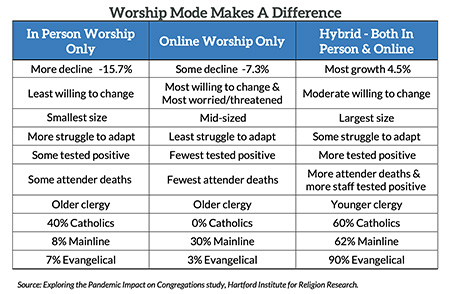As much as we would like to have definitive answers regarding the impact of the pandemic on congregational life in the United States, and even with some people and organizations claiming to have definitive answers, there remains a lot of uncertainty.
The last 20 months have tried churches and clergy in new and challenging ways.
From challenges of public health safety and the use of technology to pressing socio-political challenges like racial injustice, political polarization, and climate change, churches and their leaders are certainly wrestling with a lot of compounding and intersecting issues.
This report contains data from the first key-informant survey of the Exploring the Pandemic Impact on Congregations: Innovation Amidst and Beyond Covid-19 project.
Drawing upon the partnership of Faith Communities Today, this survey includes an over-sampling of 13 denominational groups and a random sampling of congregations in other denominations for a total of 38 Christian denominational groups and 2,074 responses.
The online survey was fielded from mid-June to the end of August 2021.
This resulting dataset was double-weighted first to account for national representation of denominational groups and second by denominational family, region, and size groupings (see the methodology section below).
Initial Findings
This survey serves as the first glimpse of the project’s examination of how congregations are continuing to navigate the pandemic.
That picture shows congregational life is far from being “back to normal.”
This should not be surprising.
Despite the wide availability of vaccines, the emergence of the “Delta” variant made the past summer subject to the second-largest wave for both recorded cases and hospitalizations of the entire pandemic.
Thanks in part to this reality, we find that an overwhelming majority of congregations, 80%, are offering hybrid services with both in-person and remote options, 15% of congregations are solely worshipping in person and only 5% of congregations are continuing to solely worship virtually.
At first glance, congregational attendance findings appear to have matched pre-pandemic rates.
Churches reported a median attendance for in-person worship at 45 with a median attendance for online worship at 20 for a total median attendance of 65.
This number correlates with the pre-pandemic data from the 2020 Faith Communities Today Survey that also found congregations had a median attendance of 65.
Such a comparison would suggest congregational attendance has remained stable, but a closer look shows what most churches know – there has been a decline in congregational attendance, but it currently is not as severe as might be expected nor shared equally by all churches.

When asked what their attendance was in 2019, congregations in this study reported a median attendance of 75 people.
This means there has been a 12% decline overall in only two years.
For comparison, the pre-pandemic 2020 Faith Communities Today survey found a 5-year median attendance decline for all US congregations. But not all churches are experiencing the pandemic equally.
In certain churches, the decline is happening rapidly, while others are growing.
Since 2019, 35% of churches reported a decline of 25% or more in attendance and another 22% of congregations reported a decline greater than 5% but less than 25%.
Additionally, 15% of churches reported a relatively stable attendance in the past two years.
Yet 28% of congregations reported growth in the past two years, with 18% of these reporting significant growths of over 25%.
These numbers reveal how turbulent and chaotic the last two years have been on US congregations.
At the same time, when compared to pre-pandemic data, these numbers show how the pandemic has not created a new problem. Rather, it seems to be exacerbating and accelerating declining trends that congregations have been acing for years. (See the 2020 Faith Communities Today report.)
Worship in person, online or both
These trends in median attendance are affected by the delivery mode of worship services.
The 15% of congregations who report solely meeting in person also reported the steepest decline at 15.7%.
These congregations tend to be smaller in size with older clergy, are the least willing to change, and had the most struggle to adapt. These congregations represent 40% of Catholic/Orthodox, 8% of Mainline, and 7% of Evangelical congregations.
For the 5% of congregations who remain solely online, they have seen a decline of 7.3% of attendees.
These congregations tended to be more mid-sized with older clergy, are the most willing to change, and had the least struggle adapting to the pandemic.
While these congregations reported the fewest Covid-19 infections, they also reported being the most worried or threatened by the pandemic.
These congregations represent no Catholic/Orthodox, 30% of Mainline, and 3% of Evangelical congregations.
For the 80% of congregations who maintain a hybrid mode of worship (both in-person and digital delivery), they showed overall growth at 4.5%.
These congregations tended to be larger with younger clergy, reporting moderate willingness to change, and expressing some struggles to adapt.
They also reported the most infections of Covid-19 of staff and members, as well as the most congregational deaths. These congregations represent 60% of Catholic/Orthodox congregations, 62% of Main-line, and 90% of all Evangelical congregations.

Continue reading (PDF)
Additional readingNews category: Analysis and Comment.









